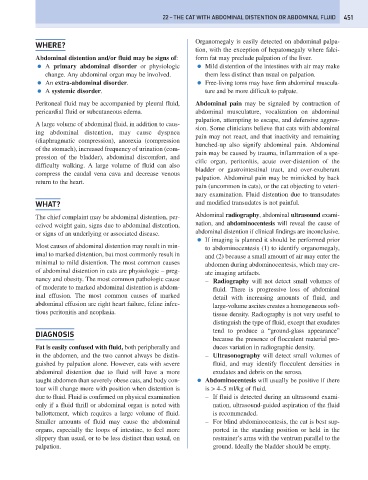Page 459 - Problem-Based Feline Medicine
P. 459
22 – THE CAT WITH ABDOMINAL DISTENTION OR ABDOMINAL FLUID 451
Organomegaly is easily detected on abdominal palpa-
WHERE?
tion, with the exception of hepatomegaly where falci-
Abdominal distention and/or fluid may be signs of: form fat may preclude palpation of the liver.
● A primary abdominal disorder or physiologic ● Mild distention of the intestines with air may make
change. Any abdominal organ may be involved. them less distinct than usual on palpation.
● An extra-abdominal disorder. ● Free-living toms may have firm abdominal muscula-
● A systemic disorder. ture and be more difficult to palpate.
Peritoneal fluid may be accompanied by pleural fluid, Abdominal pain may be signaled by contraction of
pericardial fluid or subcutaneous edema. abdominal musculature, vocalization on abdominal
palpation, attempting to escape, and defensive aggres-
A large volume of abdominal fluid, in addition to caus-
sion. Some clinicians believe that cats with abdominal
ing abdominal distention, may cause dyspnea
pain may not react, and that inactivity and remaining
(diaphragmatic compression), anorexia (compression
hunched-up also signify abdominal pain. Abdominal
of the stomach), increased frequency of urination (com-
pain may be caused by trauma, inflammation of a spe-
pression of the bladder), abdominal discomfort, and
cific organ, peritonitis, acute over-distention of the
difficulty walking. A large volume of fluid can also
bladder or gastrointestinal tract, and over-exuberant
compress the caudal vena cava and decrease venous
palpation. Abdominal pain may be mimicked by back
return to the heart.
pain (uncommon in cats), or the cat objecting to veteri-
nary examination. Fluid distention due to transudates
WHAT? and modified transudates is not painful.
The chief complaint may be abdominal distention, per- Abdominal radiography, abdominal ultrasound exami-
ceived weight gain, signs due to abdominal distention, nation, and abdominocentesis will reveal the cause of
or signs of an underlying or associated disease. abdominal distention if clinical findings are inconclusive.
● If imaging is planned it should be performed prior
Most causes of abdominal distention may result in min- to abdominocentesis (1) to identify organomegaly,
imal to marked distention, but most commonly result in and (2) because a small amount of air may enter the
minimal to mild distention. The most common causes abdomen during abdominocentesis, which may cre-
of abdominal distention in cats are physiologic – preg- ate imaging artifacts.
nancy and obesity. The most common pathologic cause – Radiography will not detect small volumes of
of moderate to marked abdominal distention is abdom- fluid. There is progressive loss of abdominal
inal effusion. The most common causes of marked detail with increasing amounts of fluid, and
abdominal effusion are right heart failure, feline infec- large-volume ascites creates a homogeneous soft-
tious peritonitis and neoplasia. tissue density. Radiography is not very useful to
distinguish the type of fluid, except that exudates
tend to produce a “ground-glass appearance”
DIAGNOSIS
because the presence of flocculent material pro-
Fat is easily confused with fluid, both peripherally and duces variation in radiographic density.
in the abdomen, and the two cannot always be distin- – Ultrasonography will detect small volumes of
guished by palpation alone. However, cats with severe fluid, and may identify flocculent densities in
abdominal distention due to fluid will have a more exudates and debris on the serosa.
taught abdomen than severely obese cats, and body con- ● Abdominocentesis will usually be positive if there
tour will change more with position when distention is is > 4–5 ml/kg of fluid.
due to fluid. Fluid is confirmed on physical examination – If fluid is detected during an ultrasound exami-
only if a fluid thrill or abdominal organ is noted with nation, ultrasound-guided aspiration of the fluid
ballottement, which requires a large volume of fluid. is recommended.
Smaller amounts of fluid may cause the abdominal – For blind abdominocentesis, the cat is best sup-
organs, especially the loops of intestine, to feel more ported in the standing position or held in the
slippery than usual, or to be less distinct than usual, on restrainer’s arms with the ventrum parallel to the
palpation. ground. Ideally the bladder should be empty.

